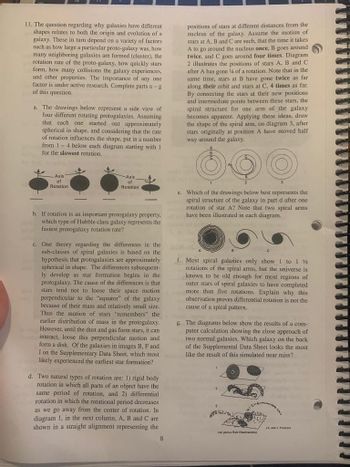
Applications and Investigations in Earth Science (9th Edition)
9th Edition
ISBN: 9780134746241
Author: Edward J. Tarbuck, Frederick K. Lutgens, Dennis G. Tasa
Publisher: PEARSON
expand_more
expand_more
format_list_bulleted
Question

Transcribed Image Text:C
11. The question regarding why galaxies have different
shapes relates to both the origin and evolution of a
galaxy. These in turn depend on a variety of factors
such as how large a particular proto-galaxy was, how
many neighboring galaxies are formed (cluster), the
rotation rate of the proto-galaxy, how quickly stars
form, how many collisions the galaxy experiences,
and other properties. The importance of any one
factor is under active research. Complete parts a-g
of this question.
a. The drawings below represent a side view of
four different rotating protogalaxies. Assuming
that each one started out approximately
spherical in shape, and considering that the rate
of rotation influences the shape, put in a number
from 1-4 below each diagram starting with I
for the slowest rotation.
positions of stars at different distances from the
nucleus of the galaxy. Assume the motion of
stars at A, B and C are such, that the time it takes
A to go around the nucleus once, B goes around
twice, and C goes around four times. Diagram
2 illustrates the positions of stars A, B and C
after A has gone 4 of a rotation. Note that in the
same time, stars at B have gone twice as far
along their orbit and stars at C, 4 times as far.
By connecting the stars at their new positions
and intermediate points between these stars, the
spiral structure for one arm of the galaxy
becomes apparent. Applying these ideas, draw
the shape of the spiral arm, on diagram 3, after
stars originally at position A have moved half
way around the galaxy.
Axis
of
Rotation
Axis
of
Rotation
b. If rotation is an important protogalaxy property,
which type of Hubble class galaxy represents the
fastest protogalaxy rotation rate?
c. One theory regarding the differences in the
sub-classes of spiral galaxies is based on the
hypothesis that protogalaxies are approximately
spherical in shape. The differences subsequent-
ly develop as star formation begins in the
protogalaxy. The cause of the differences is that
stars tend not to loose their space motion
perpendicular to the "equator" of the galaxy
because of their mass and relatively small size.
Thus the motion of stars "remembers" the
earlier distribution of mass in the protogalaxy.
However, until the dust and gas form stars, it can
interact, loose this perpendicular motion and
form a disk. Of the galaxies in images B, F and
I on the Supplementary Data Sheet, which most
likely experienced the earliest star formation?
d. Two natural types of rotation are: 1) rigid body
rotation in which all parts of an object have the
same period of rotation, and 2) differential
rotation in which the rotational period decreases
as we go away from the center of rotation. In
diagram 1, in the next column, A, B and C are
shown in a straight alignment representing the
3
e. Which of the drawings below best represents the
spiral structure of the galaxy in part d after one
rotation of star A? Note that two spiral arms.
have been illustrated in each diagram.
f. Most spiral galaxies only show 1 to 1½
rotations of the spiral arms, but the universe is
known to be old enough for most regions of
outer stars of spiral galaxies to have completed
more than five rotations. Explain why this
observation proves differential rotation is not the
cause of a spiral pattern.
g. The diagrams below show the results of a com-
puter calculation showing the close approach of
two normal galaxies. Which galaxy on the back
of the Supplemental Data Sheet looks the most
like the result of this simulated near miss?
3
(A. and Toome)
(AD Hale O
8
Expert Solution
This question has been solved!
Explore an expertly crafted, step-by-step solution for a thorough understanding of key concepts.
Step by stepSolved in 3 steps with 2 images

Knowledge Booster
Recommended textbooks for you
 Applications and Investigations in Earth Science ...Earth ScienceISBN:9780134746241Author:Edward J. Tarbuck, Frederick K. Lutgens, Dennis G. TasaPublisher:PEARSON
Applications and Investigations in Earth Science ...Earth ScienceISBN:9780134746241Author:Edward J. Tarbuck, Frederick K. Lutgens, Dennis G. TasaPublisher:PEARSON Exercises for Weather & Climate (9th Edition)Earth ScienceISBN:9780134041360Author:Greg CarbonePublisher:PEARSON
Exercises for Weather & Climate (9th Edition)Earth ScienceISBN:9780134041360Author:Greg CarbonePublisher:PEARSON Environmental ScienceEarth ScienceISBN:9781260153125Author:William P Cunningham Prof., Mary Ann Cunningham ProfessorPublisher:McGraw-Hill Education
Environmental ScienceEarth ScienceISBN:9781260153125Author:William P Cunningham Prof., Mary Ann Cunningham ProfessorPublisher:McGraw-Hill Education Earth Science (15th Edition)Earth ScienceISBN:9780134543536Author:Edward J. Tarbuck, Frederick K. Lutgens, Dennis G. TasaPublisher:PEARSON
Earth Science (15th Edition)Earth ScienceISBN:9780134543536Author:Edward J. Tarbuck, Frederick K. Lutgens, Dennis G. TasaPublisher:PEARSON Environmental Science (MindTap Course List)Earth ScienceISBN:9781337569613Author:G. Tyler Miller, Scott SpoolmanPublisher:Cengage Learning
Environmental Science (MindTap Course List)Earth ScienceISBN:9781337569613Author:G. Tyler Miller, Scott SpoolmanPublisher:Cengage Learning Physical GeologyEarth ScienceISBN:9781259916823Author:Plummer, Charles C., CARLSON, Diane H., Hammersley, LisaPublisher:Mcgraw-hill Education,
Physical GeologyEarth ScienceISBN:9781259916823Author:Plummer, Charles C., CARLSON, Diane H., Hammersley, LisaPublisher:Mcgraw-hill Education,

Applications and Investigations in Earth Science ...
Earth Science
ISBN:9780134746241
Author:Edward J. Tarbuck, Frederick K. Lutgens, Dennis G. Tasa
Publisher:PEARSON

Exercises for Weather & Climate (9th Edition)
Earth Science
ISBN:9780134041360
Author:Greg Carbone
Publisher:PEARSON

Environmental Science
Earth Science
ISBN:9781260153125
Author:William P Cunningham Prof., Mary Ann Cunningham Professor
Publisher:McGraw-Hill Education

Earth Science (15th Edition)
Earth Science
ISBN:9780134543536
Author:Edward J. Tarbuck, Frederick K. Lutgens, Dennis G. Tasa
Publisher:PEARSON

Environmental Science (MindTap Course List)
Earth Science
ISBN:9781337569613
Author:G. Tyler Miller, Scott Spoolman
Publisher:Cengage Learning

Physical Geology
Earth Science
ISBN:9781259916823
Author:Plummer, Charles C., CARLSON, Diane H., Hammersley, Lisa
Publisher:Mcgraw-hill Education,